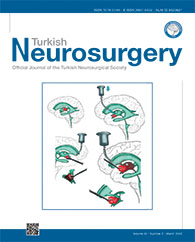2Health Ministry of Turkey, Institute of Forensic Medicine, Istanbul, Turkey
3Istanbul University, Istanbul Faculty of Medicine, Department of Radiology, Istanbul, Turkey DOI : 10.5137/1019-5149.JTN.37281-21.2 AIM: To demonstrate the feasibility of stent application to the third ventricular floor during endoscopic third ventriculostomy (ETV).
MATERIAL and METHODS: We performed the ETV procedure on four fresh cadavers not exposed to head trauma. The neuroendoscope was introduced into the third ventricle under ultrasonography guidance. The stoma was opened with a neuroballoon in the third ventricular floor in three cases and with the catheter carrying the stent in the remaining case. The balloon-expandable stent was 8 mm in length and 4 and 4.5 mm in diameter. The distal end of the stent was placed in the prepontine cistern, without contact with the vascular structures in the cistern, and the proximal end was placed in the stoma, with its proximal end in the third ventricle.
RESULTS: In all the cases, the stent was fixed in the targeted position. Then, the head cavity was opened. The brain was extracted from the skull for pathological analysis. The stents were placed in front of the mamillary bodies in all four cases, fixed around the stoma, which was opened previously. No significant compression on the structures around the prepontine cisterna and on the basilar artery was observed.
CONCLUSION: Expandable stents may be useful and technically safe in creating and maintaining the stomal opening in ETV.
Keywords : Hydrocephalus, Endoscopic third ventriculostomy, Stent, Cardiac stent, Stoma closure




